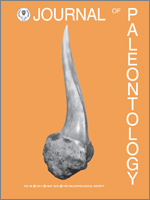Teeth of a new freshwater dasyatoid ray recovered from the latest middle Eocene Brian Head Formation of southern Utah represent the youngest freshwater stingray so far known in the fossil record of North America. The crown morphology of Saltirius utahensis n. gen. n. sp. exhibits strong sexual dimorphism, with the presumed males bearing two prominent margino-labial protuberances and a bifid cusp that produces a saltire-like outline. This unique crown separates this genus and species from any known extinct or extant myliobatiform, but does have some resemblance to the crown of Asterotrygon maloneyi from the lower Eocene Green River Formation of Wyoming. The occurrence of S. utahensis in the Brian Head Formation provides additional evidence for the persistence of warm subtropical temperatures during the late Eocene in southern Utah.
How to translate text using browser tools
1 May 2014
A new genus and species of freshwater stingray (Myliobatiformes, Dasyatoidea) from the latest middle Eocene of Utah, U.S.A.
Todd D. Cook,
Jeffrey G. Eaton,
Michael G. Newbrey,
Mark V. H. Wilson
ACCESS THE FULL ARTICLE

Journal of Paleontology
Vol. 88 • No. 3
May 2014
Vol. 88 • No. 3
May 2014




